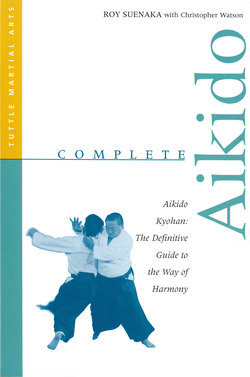Читать книгу Complete Aikido - Christopher Watson G. - Страница 7
На сайте Литреса книга снята с продажи.
ОглавлениеFOREWORD
For many years, martial artists of varying degrees of expertise have written books on aikido. Recently, more and more books have been written, but only a select few of these books have some genuine value. Aikido theory can be very sophisticated and complex, in turn making the physical aspects, the techniques, seem extremely difficult and varied. As in all things, over the years aikido has changed, evolved or, in some cases, regressed. To have any significant value, a good book should demonstrate consistency within aikido, and have a systematic purpose. The purpose of Complete Aikido: Aikido Kyohan is to provide this consistency.
Aikido is often defined as a peaceful martial art, an art of love, spirituality and mental discipline. While this is correct, the true and legitimate historical aspects, martial and practical applications of aikido have oftentimes been grossly misrepresented. This compels me to address the current state of aikido. Some styles teach aikido primarily as a philosophy of life and as a means of spiritual development and social intercourse, ignoring the defensive or martial aspects, treating them as a means of exercise. Still other styles teach aikido solely to vanquish an adversary as quickly as possible, ignoring the spiritual aspects. While all of these motives are valid reasons to study any martial art, separately, they are not conducive to the understanding and continued integrated development of the total martial art form aikido was meant to be.
Further, as a result of these differing conceptions, aikido has often been described as an ineffective martial art, a formerly effective art that has been “watered-down,” a martial arts dance form, and other derogatory definitions. The truth of the matter is, if aikido is practiced diligently and sincerely, with emphasis on its original martial traditions and standards, it is one of the most effective means of self-defense in the world. The techniques in aikido are extremely potent, and can cause crippling or even fatal injury. However, if practiced under ideal conditions with a knowledgeable teacher, one can learn how to apply aiki principles in everyday life. It is this integrated approach that defines true aikido, and one should seek out an aikido style that teaches self-control, humility, confidence, and discipline, emphasizes spirituality, and yet is ultimately street-effective.
While this book is titled Complete Aikido: Aikido Kyohan, it is considered the canon, or master text, of Suenaka-ha Testugaku-ho aikido, and is meant to provide an overview of this style, as well as a grounding in the basic principles of all aikido styles. I have also attempted to systematize and simplify the practice of aikido in general; to provide an integrated approach by explaining the philosophy, history and evolution of aikido, so the reader may understand the many often confusing or misinterpreted aspects of this martial art.
I have been very fortunate to have studied many different martial arts in my life. My initiation took place as a child in Hawaii, studying with my Dad, and continued under other highly-acclaimed teachers there. In 1958, I opened one of the first aikido schools in California and the continental United States. The Air Force then sent me to Japan and Okinawa, where I met and studied under many of the foremost martial arts teachers in the world. My life has been a quest to learn as much as I can, to become the best I can be as an integrated human being. It is my hope that Complete Aikido: Aikido Kyohan helps you to do the same. As the saying goes: Perfect Practice Makes Perfect.
The Morihei Ueshiba quote appearing on page XIII is excerpted from The Art of Peace, translated by John Stevens, © 1992. Reprinted by arrangement with Shambhala Publications, Inc., 300 Massachusetts Ave., Boston, MA 02115.
The Morihei Ueshiba quote appearing on page 11 is excerpted from The Spirit of Aikido, by Kisshomaru Ueshiba, ©1984. Reprinted by arrangement with Kodansha International Ltd., 17-14, Otowa 1-chome, Bunkyo-ku, Tokyo 112, Japan.
The kanji calligraphy appearing on the chapter pages of the biographical section read shin-shin renma, and translates as “polishing/perfection of the mind and body.”
All photographs appearing in Complete Aikido: Aikido Kyohan are © 1997 by the authors, and may not be reproduced or otherwise used without permission.
